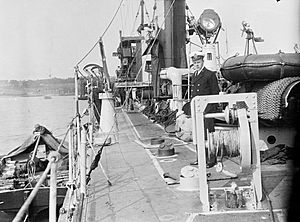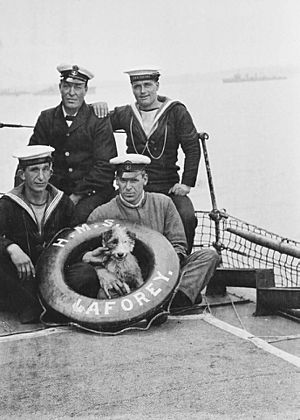HMS Laforey (1913) facts for kids

On board the destroyer Laforey at moorings in Harwich harbour
|
|
Quick facts for kids History |
|
|---|---|
| Name | HMS Laforey |
| Namesake | Francis Laforey |
| Ordered | 29 March 1912 |
| Builder | Fairfield Shipbuilding and Engineering Company |
| Laid down | 9 September 1912 |
| Launched | 1913 |
| Fate | Struck a mine off France, 23 March 1917 |
| General characteristics | |
| Class and type | Laforey-class destroyer |
| Displacement | 965–1,300 long tons (980–1,321 t) |
| Length | 269 ft (82 m) |
| Beam | 26 ft 9 in (8.15 m) |
| Draught | 9 ft 6 in (2.90 m) |
| Installed power | 24,500 shp (18,300 kW) |
| Propulsion |
|
| Speed | 29 kn (33 mph; 54 km/h) |
| Complement | 73 |
| Armament |
|
HMS Laforey was a special warship, the first of her kind, built for the Royal Navy in the United Kingdom. She was launched in 1913, just before World War I started. Laforey became part of the Dover Patrol, a group of ships protecting the English Channel.
Laforey fought in many battles against German torpedo boats, like the Battle off Noordhinder Bank. Sadly, in 1917, Laforey hit a British mine and sank while helping cargo ships get to France. The ship was named after Francis Laforey, a brave captain who fought in the Battle of Trafalgar in 1805.
Building the Laforey
On March 29, 1912, the British Admiralty ordered the first 16 destroyers of the L-class. These ships were later renamed the Laforey-class destroyer class. Four of these ships, including the lead ship, were ordered from the Fairfield Shipbuilding and Engineering Company.
From Florizel to Laforey
The ship was first named Florizel. It was built at Fairfield's shipyard in Govan, Glasgow. Work started on September 9, 1912, and the ship was launched on August 22, 1913. On September 30, 1913, the Admiralty decided to rename all L-class ships with names starting with "L". So, Florizel became Laforey. The ship was finished in February 1914.
Ship's Size and Power
Laforey was about 269 feet (82 m) long. It had a width of 27 feet 6 inches (8.38 m) and sat 10 feet 10 inches (3.30 m) deep in the water. The ship weighed about 962 long tons (977 t) normally.
It was powered by four large boilers that made steam. This steam turned two steam turbines, which spun the ship's propellers. This gave Laforey 24,500 shaft horsepower (18,300 kW) of power. The ship could reach a speed of 29 knots (54 km/h; 33 mph), which is very fast for a warship. It had a crew of 73 officers and sailors.
Weapons on Board
Laforey was armed with three main guns, called QF 4-inch guns. These guns were placed along the center of the ship. It also carried two sets of twin torpedo tubes, which could fire 21-inch torpedoes. The ship was also designed to carry four naval mines, but these were never used.
Service in World War I
When Laforey was ready, it joined the 3rd Destroyer Flotilla. This group of ships became part of the Harwich Force when World War I began. Commodore Reginald Tyrwhitt was in charge of this force.
Battle of Heligoland Bight (1914)
On August 28, 1914, Commodore Tyrwhitt led the Harwich Force, including Laforey, into the North Sea. They wanted to surprise German warships near the German coast. This led to the Battle of Heligoland Bight. In this battle, three German cruisers and one destroyer were sunk. Laforey was not damaged during this fight.
Battle of Dogger Bank (1915)
On January 23, 1915, Laforey took part in another mission. The British knew from secret messages that German battlecruisers were planning a raid. The Harwich Force, along with Admiral David Beatty's battlecruisers, went to stop them. This became the Battle of Dogger Bank. It was a high-speed chase. Most of the destroyers, including Laforey, were not fast enough to keep up with the battlecruisers.
Battle off Noordhinder Bank (1915)
On May 1, 1915, a German submarine sank the old British destroyer HMS Recruit. Laforey and three sister ships were sent to find the submarine. Two German torpedo boats attacked British fishing boats, sinking one. The four British destroyers arrived and sank both German ships. This was known as the Battle off Noordhinder Bank.
Gallipoli Campaign (1915)
In October 1915, Laforey joined the 5th Destroyer Flotilla in the Mediterranean Fleet. She helped with the evacuation of troops from ANZAC Cove in December. Laforey helped destroy supplies left behind as the troops pulled out. She stayed with this group until February 1916.
Return to Harwich Force (1916)
Laforey then rejoined the Harwich Force. She helped escort the seaplane carrier HMS Vindex. Vindex launched an air attack against a German Zeppelin base, but it was not successful. The Harwich Force was kept as a backup during the Battle of Jutland in May 1916. When the battleship Marlborough was damaged, Laforey was one of the destroyers sent to escort it to safety.
Dover Patrol (1916-1917)
In October 1916, Laforey was sent to help the Dover Patrol. This group protected shipping in the Downs and the Dover Barrage, which had anti-submarine nets. On October 26, German torpedo boats attacked the Dover Barrage. Laforey and other destroyers were sent to intercept them. In a confusing fight, the destroyer Nubian was badly damaged. Laforey was too far away to join the fight.
In early 1917, Laforey joined the 6th Destroyer Flotilla as part of the Dover Patrol. On the night of March 17–18, 1917, Laforey was on patrol when Germans launched another torpedo boat raid. The destroyer Paragon was sunk. Laforey investigated and found debris. While searching for survivors, German torpedo boats attacked again, damaging HMS Llewellyn. The Germans escaped without being seen.
The Sinking of Laforey
On March 23, 1917, Laforey was escorting several cargo ships to France. She was with her sister ships Laertes and Lark, and the destroyer Melpomene. The cargo ships arrived safely.
However, on the way back, around 4:30 PM, a huge explosion happened in the middle of Laforey. The ship immediately broke in half. The back part of the ship sank quickly. The front part stayed afloat for a short time before sinking too. Laertes tried to rescue survivors.
Laforey had been sunk by a British-laid mine. Only 18 of the 76 people on board survived. The wreck of Laforey lies about 10 miles south of Shoreham-by-Sea in England. It is now a popular spot for recreational divers.


